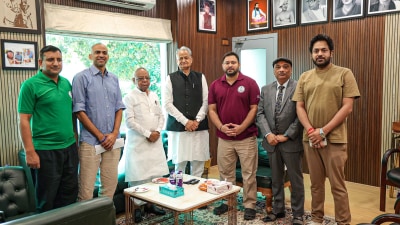World Stroke Day | BP, diabetes, smoking increase the risk of brain stroke: Expert
Dr Anil Dhingra, associate director neurology, emphasised the need for correctly identifying the cause of stroke which could be due to blockage of a blood vessel or leakage from a blood vessel, thus causing a haemorrhage.
 A stroke is usually triggered by hypertension, diabetes, high cholesterol level, obesity, smoking, excessive alcohol consumption and cardiac conditions. (Representative/Getty Images)
A stroke is usually triggered by hypertension, diabetes, high cholesterol level, obesity, smoking, excessive alcohol consumption and cardiac conditions. (Representative/Getty Images) Stroke is the second leading cause of death and long-term disability in the world. However, awareness levels continue to be low among people about its symptoms and warning signs. To make the masses aware about stroke, World Stroke Day is observed on October 29 every year. The theme of this year’s event was ‘Together we are #Greater Than Stroke’.
Dr H S Mann, Director, Department of Neurology, Fortis Hospital Mohali, tells The Indian Express, a stroke occurs when blood circulation to a part of the brain is blocked (ischemic stroke) or when a blood vessel in the brain bursts (haemorrhagic stroke). “This may lead to death of the brain cells owing to decreased blood flow and lack of oxygen. It is a medical emergency and needs urgent medical intervention.”
A stroke is usually triggered by hypertension, diabetes, high cholesterol level, obesity, smoking, excessive alcohol consumption and cardiac conditions. The symptoms include loss of balance, visual complaints, sudden weakness or paralysis of the face, arm or leg (especially on one side of the body), and sudden speech difficulty.
Mann says about 20% stroke cases are seen in people below 45 years of age. Other additional risk factors include cardiovascular conditions, dissection of arteries, substance abuse and vasculitis. He says, “Time is crucial as loss of oxygen to the brain cells for even one minute can cause loss of 1.8 million neurons. Immediate treatment with intravenous thrombolysis (within 4.5 hours) with or without mechanical thrombectomy (up to 24 hours in select patients) is required.”
Dr Anil Dhingra, associate director neurology, emphasised the need for correctly identifying the cause of stroke which could be due to blockage of a blood vessel or leakage from a blood vessel, thus causing a haemorrhage.
Dr Aman Batish, associate consultant, neurology, says stroke is preventable in over 80% of cases and annual screening for high blood pressure, blood sugar and cholesterol in people above 30 is important. “To reduce the risk, people must control their BP, diabetes and cholesterol; quit smoking; maintain a healthy weight; eat a healthy diet low in sodium with 5+ servings of fruits and vegetables per day; and increase physical activity, aiming for at least 150 minutes per week.”







